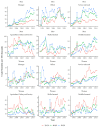Suicide Trends over Time by Occupation in Korea and Their Relationship to Economic Downturns
- PMID: 31195664
- PMCID: PMC6604014
- DOI: 10.3390/ijerph16112007
Suicide Trends over Time by Occupation in Korea and Their Relationship to Economic Downturns
Abstract
We analyzed suicide mortality by occupation using administrative data from 1993 to 2016. Methods: National death records from 1993 to 2016 of the Korea National Statistical Office (KNSO) were used. Suicidal death was taken from Korean Classification of Disease codes as intentional self-harm (X60-X84) and sequelae of intentional self-harm (Y870). Occupational groups were categorized into "Manager," "Officer," "Service-Trade," "Agricultural-Fishery-Forestry" (AFF), "Skilled Manual," and "Unskilled Manual." Direct standardized mortality (DSM) and standardized mortality ratio (SMR) with 95% confidence interval (95% CI) were calculated. Overall, suicide rates increased during economic downturns, especially among lower socio-economic occupation classes. Both DSM and SMR were highest in AFF, followed by Unskilled Manual, Service-Trade, Officer, Skilled Manual, and Manager categories among men, whereas women showed the highest DSM and SMR in AFF, followed by Service-Trade, Officer, Unskilled Manual, Manager, and Skilled Manual categories. The age-stratified analysis showed that age groups with increasing trends in suicide differed according to occupation and gender. In certain occupational groups, the time-point prevalence fluctuated with socio-economic background in suicidal mortality and differed by age and gender.
Keywords: economics; occupations; suicide.
Conflict of interest statement
The authors declare no conflict of interest. The funders had no role in the design of the study; in the collection, analyses, or interpretation of data; in the writing of the manuscript; or in the decision to publish the results.
Figures


Similar articles
-
Mortality of Suicide and Cerebro-Cardiovascular Diseases by Occupation in Korea, 1997-2020.Int J Environ Res Public Health. 2022 Aug 13;19(16):10001. doi: 10.3390/ijerph191610001. Int J Environ Res Public Health. 2022. PMID: 36011632 Free PMC article.
-
Occupation, work-related stress, and personal characteristics among suicide deaths with occupation-related compensation claims in Korea.J Occup Health. 2021 Jan;63(1):e12233. doi: 10.1002/1348-9585.12233. J Occup Health. 2021. PMID: 33991042 Free PMC article.
-
Suicide mortality follow-up of the Swiss National Cohort (1990-2014): sex-specific risk estimates by occupational socio-economic group in working-age population.Soc Psychiatry Psychiatr Epidemiol. 2019 Dec;54(12):1483-1495. doi: 10.1007/s00127-019-01728-4. Epub 2019 May 24. Soc Psychiatry Psychiatr Epidemiol. 2019. PMID: 31127347
-
Suicide Mortality Patterns in Greek Work Force before and during the Economic Crisis.Int J Environ Res Public Health. 2019 Feb 6;16(3):469. doi: 10.3390/ijerph16030469. Int J Environ Res Public Health. 2019. PMID: 30736267 Free PMC article.
-
Overwork-related disorders and recent improvement of national policy in South Korea.J Occup Health. 2019 Jul;61(4):288-296. doi: 10.1002/1348-9585.12060. Epub 2019 Apr 25. J Occup Health. 2019. PMID: 31025505 Free PMC article. Review.
Cited by
-
Prevalence of somatic and psychiatric morbidity across occupations in Switzerland and its correlation with suicide mortality: results from the Swiss National Cohort (1990-2014).BMC Psychiatry. 2020 Jun 22;20(1):324. doi: 10.1186/s12888-020-02733-7. BMC Psychiatry. 2020. PMID: 32571249 Free PMC article.
-
Mortality of Suicide and Cerebro-Cardiovascular Diseases by Occupation in Korea, 1997-2020.Int J Environ Res Public Health. 2022 Aug 13;19(16):10001. doi: 10.3390/ijerph191610001. Int J Environ Res Public Health. 2022. PMID: 36011632 Free PMC article.
-
Depressive Symptoms, Suicidal Ideation, and Mental Health Service Use of Industrial Workers: Evidence from Vietnam.Int J Environ Res Public Health. 2020 Apr 23;17(8):2929. doi: 10.3390/ijerph17082929. Int J Environ Res Public Health. 2020. PMID: 32340335 Free PMC article.
-
System dynamics simulation of occupational health and safety management causal model based on NetLogo.Heliyon. 2023 Jul 27;9(8):e18752. doi: 10.1016/j.heliyon.2023.e18752. eCollection 2023 Aug. Heliyon. 2023. PMID: 37554791 Free PMC article.
-
Suicide Overall and Suicide by Pesticide Rates among South Korean Workers: A 15-Year Population-Based Study.Int J Environ Res Public Health. 2019 Dec 3;16(23):4866. doi: 10.3390/ijerph16234866. Int J Environ Res Public Health. 2019. PMID: 31816899 Free PMC article.
References
-
- Organisation for Economic Co-operation and Development (OECD) Health at a Glance 2017: OECD Indicators. OECD Publishing; Paris, France: 2017.
-
- Durkheim E. Suicide: A Study in Sociology [1897] (Translated by J.A. Spaulding and G. Simpson) The Free Press; Glencoe, IL, USA: 1951.
Publication types
MeSH terms
LinkOut - more resources
Full Text Sources
Medical

